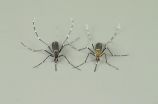(Press-News.org) SEATTLE - Preterm birth is now the leading cause of death for children under 5 worldwide, and a new scientific paper reveals a startling lack of knowledge about what causes it and how to prevent it.
Published in the November issue of Science Translational Medicine, "Prevention of Preterm Birth: Harnessing Science to Address the Global Epidemic" shines a light on the urgent need for a larger, coordinated research effort to discover how to identify women at risk of preterm birth and develop prevention interventions.
"There are not enough resources dedicated to researching the complex problem of preterm birth and its prevention," said lead author Craig Rubens, MD, PhD, executive director of the Global Alliance to Prevent Prematurity and Stillbirth (GAPPS), an initiative of Seattle Children's. "This paper is a clarion call to the scientific community, that investing in preterm birth research will pay dividends with millions of lives saved and also save billions of dollars in healthcare expenses associated with preterm birth."
The paper provides an analysis of nine pathways that can contribute to preterm birth, including genetics, psychological and environmental stress, and infection and inflammation. It notes that approximately 70 percent of preterm births are spontaneous, and there are few known interventions that can delay labor once it has begun.
"It's easy to look at preterm birth and view it as a single endpoint," Rubens said. "In reality, preterm birth can have many causes and pathways. Although the end result is the same, we need to understand the different pathways so we can develop ways to prevent them."
The authors note that there are many factors that increase a woman's likelihood of a preterm birth - such as periodontal disease, poor pregnancy weight gain, and cigarette use - but there is not much understanding of why different factors increase risk. For example, in the United States, babies of non-Hispanic black women have preterm birth rates that are 40 percent greater than those of Hispanic and non-Hispanic white women, and this difference persists even after adjustment for maternal socioeconomic status and education. Unfortunately, even less is understood about the risk factors, disparities, and causes of preterm birth in high-burden, low-resource countries.
There is a need for more research "to better understand the biology of pregnancy and how [different] risk factors contribute to preterm birth in order to develop effective strategies for early detection and prevention," the authors write.
The paper distills the state of preterm birth research into a central analysis, while conveying the tremendous burden of preterm birth and the urgent need for more research to understand its causes. The authors point out some major challenges, including the fact that pregnancy research involves studying two individuals - the mother and the fetus - at the same time, as well as the influence of the genetics of the father. They also pose a number of questions that can help lay the foundation for what future research should seek to address and how research can be translated into practical interventions. Additionally, the paper identifies barriers to pregnancy research, including the perception of risk and liability, which deters scientists and pharmaceutical companies from testing diagnostics and therapeutics during pregnancy.
The authors note, "The gaps in knowledge about the basic biology of both term and preterm pregnancy, including what constitutes normal gestational length in any given population, leave clinicians with few tools to prevent [preterm birth]. This is the fundamental reason that most prematurity intervention efforts are actually aimed at care of the woman in preterm labor and care of the preterm neonate, rather than prolonging gestation or stopping labor."
Every year, more than 15 million babies are born too soon around the world, and more than one million of them don't survive infancy. Even in high-income countries with advanced medical technology, preterm birth remains the leading cause of infant mortality. In the U.S., 1 in 9 babies is born too soon, and studies have found that preterm birth costs society more than $26 billion a year in the U.S. alone.
INFORMATION:
More information, including a copy of the paper, can be found online at the Science Translational Medicine press package at http://www.eurekalert.org/jrnls/scitransmed. You will need your user ID and password to access this information.
GAPPS
The Global Alliance to Prevent Prematurity and Stillbirth, an initiative of Seattle Children's, leads a collaborative, global effort to increase awareness and accelerate innovative research and interventions that will improve maternal, newborn and child health outcomes around the world. Join us on Facebook and Twitter, and learn more at http://www.gapps.org.
Seattle Children's
Consistently ranked as one of the best children's hospitals in the country by U.S. News & World Report, Children's serves as the pediatric and adolescent academic medical referral center for the largest landmass of any children's hospital in the country (Washington, Alaska, Montana and Idaho). For more than 100 years, Children's has been delivering superior patient care and advancing new treatments through pediatric research. Children's serves as the primary teaching, clinical and research site for the Department of Pediatrics at the University of Washington School of Medicine. The hospital works in partnership with Seattle Children's Research Institute and Seattle Children's Hospital Foundation. Together they are Seattle Children's, known for setting new standards in superior patient care for more than 100 years. For more information visit http://www.seattlechildrens.org.
Older women with disordered breathing during sleep were found to be at greater risk of decline in the ability to perform daily activities, such as grocery shopping and meal preparation, according to a new study led by researchers at the Johns Hopkins Bloomberg School of Public Health and the University of California, San Francisco.
The study was published Nov. 6 in the online edition of the Journal of the American Geriatrics Society.
The findings are notable given the aging of the population - an estimated 3.7 million Americans will turn 65 in 2015, and by 2030, 19 ...
In school-age children previously diagnosed with depression as preschoolers, a key brain region involved in emotion is smaller than in their peers who were not depressed, scientists have shown.
The research, by a team at Washington University School of Medicine in St. Louis, also suggests that the size of the brain's right anterior insula may predict the risk of future bouts of depression, potentially giving researchers an anatomical marker to identify those at high risk for recurrence.
The study is published online Nov. 12 in the journal JAMA Psychiatry.
There is ...
One of the world's deadliest mosquitoes sustains its taste for human blood thanks in part to a genetic tweak that makes it more sensitive to human odor, according to new research.
Researchers report in the journal Nature that the yellow fever mosquito contains a version of an odor-detecting gene in its antennae that is highly attuned to sulcatone, a compound prevalent in human odor. The researchers found that the gene, AaegOr4, is more abundant and more sensitive in the human-preferring "domestic" form of the yellow fever mosquito than in its ancestral "forest" form that ...
Adding tiny amounts of vegetable puree to milk and then rice at the time of weaning makes children more likely to eat vegetables, new University of Leeds research shows.
Infants who consumed either milk (breast milk or formula) followed by rice mixed with vegetable puree ate nearly half as many vegetables again as infants who ate just milk followed by baby rice.
Professor Marion Hetherington, of the School of Psychology at the University of Leeds, led the study. She said: "We took inspiration from French mothers, as previous studies in this area have shown that they ...
(SACRAMENTO, Calif.) -- In its first clinical application in pediatric patients, an investigational medication developed and manufactured at UC Davis has been found to effectively treat children with life-threatening and difficult-to-control epileptic seizures without side effects, according to a research report by scientists at UC Davis and Northwestern University.
The investigational formulation of allopregnanolone was manufactured by UC Davis Health System's Good Manufacturing Practice Laboratory. Two children were treated with the allopregnanolone formulation, one ...
LA JOLLA, CA - November 12, 2014 - Driving to work becomes routine--but could you drive the entire way in reverse gear? Humans, like many animals, are accustomed to seeing objects pass behind us as we go forward. Moving backwards feels unnatural.
In a new study, scientists from The Scripps Research Institute (TSRI) reveal that moving forward actually trains the brain to perceive the world normally. The findings also show that the relationship between neurons in the eye and the brain is more complicated than previously thought--in fact, the order in which we see things ...
(MEMPHIS, Tenn. - November 12, 2014) An international collaboration has identified frequent mutations in two genes that often occur together in Ewing sarcoma (EWS) and that define a subtype of the cancer associated with reduced survival. The research, conducted by the St. Jude Children's Research Hospital-Washington University Pediatric Cancer Genome Project and the Institut Curie-Inserm through the International Cancer Genome Consortium, appears in the current issue of the scientific journal Cancer Discovery.
Mutations in the genes STAG2 and TP53 have previously been ...
Giant otters may have a vocal repertoire with 22 distinct vocalization types produced by adults and 11 neonate vocalization types, according to a study published November 12, 2014 in the open-access journal PLOS ONE by Christina Mumm and Mirjam Knörnschild from University of Ulm, Germany.
Giant otters, found in South America, are very social and frequently vocalizing animals. They live in groups that may vary, but generally include a reproductive pair and their offspring, born in different years. Individuals engage in shared group activities and hold different social ...
Using fewer than twenty genomes, researchers were unable to find rare protein-altering variants significantly associated with extreme longevity, according to a study published November 12, 2014 in the open-access journal PLOS ONE by Hinco Gierman from Stanford University and colleagues.
Supercentenarians are the world's oldest people, living beyond 110 years of age. Seventy-four are alive worldwide, with twenty-two living in the United States. The authors of this study performed whole-genome sequencing on 17 supercentenarians to explore the genetic basis underlying ...
An educational approach in kindergarten focused on the development of executive functions--the ability to avoid distractions, focus attention, hold relevant details in working memory, and regulate impulsive behavior--in children improved academic learning in and beyond kindergarten, helping to overcome deficits in school readiness associated with poverty, according to a study published November 12, 2014 in the open-access journal PLOS ONE by Clancy Blair and C. Cybele Raver from New York University.
Based on the results, the authors suggest that executive function ...


